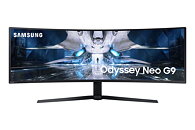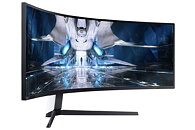Tuesday, July 27th 2021

Samsung Announces Odyssey Neo G9 Gaming Monitor
Samsung Electronics, today announced the global launch of its next-generation curved gaming monitor, the Odyssey Neo G9, enhanced with Quantum Mini LED technology. The Odyssey Neo G9 joins the Odyssey lineup, taking gaming to the next level with Quantum Matrix technology, supported by Quantum Mini LED display and Quantum HDR 2000 for an immersive gaming experience.
With the previous launch of the Odyssey G9 in 2020, Samsung pushed the boundaries of premium gaming monitors with smooth and brilliant picture quality. Now with the industry's first Quantum Mini LED curved display delivering the most refined detail regardless of the game played, the Odyssey Neo G9 is catapulting the gaming monitor category forward. Featuring Quantum Matrix Technology combined with super-fast response and refresh rates, Odyssey Neo G9 delivers an unrivaled dynamic picture and premium performance for all gamers.The Odyssey Neo G9 utilizes the same Mini LED technology built into Samsung's latest Neo QLED lineup. This next-generation display technology is enabled by a new light source, Quantum Mini LED. At 1/40 the height of a conventional LED,1 the Quantum Mini LED has incredibly thin micro layers filled with many more LEDs.
Additionally, Quantum Matrix Technology, which harnesses enhanced 12-bit gradation for greater control of the light source - the Quantum Mini LEDs makes dark areas darker and bright areas brighter with 2,048 dimming zones, ensuring viewers enjoy the content as it is meant to be seen. Quantum HDR 2000 offers a peak brightness of 2,000 nits, with certification received from VDE (Verband Deutscher Elektrotechniker), alongside a static contrast ratio of 1,000,000:1. In addition, Samsung's cutting-edge picture quality technology provides perfect black and white levels, for unparalleled contrast and immaculate detail.
Based on the high performance technology pioneered by the current Odyssey G9, the Odyssey Neo G9 features an ultra-wide 49-inch display with a 32:9 aspect ratio that offers Dual Quad High-Definition (DQHD; 5,120×1,440 resolution) with a rapid, 240 Hz refresh rate and 1 ms response time. The futuristic and immersive 1000R curvature of the monitor was certified by TÜV Rheinland, a leading international certification organization, awarding it their Eye Comfort certificate.
The Odyssey Neo G9 provides Adaptive Sync on DisplayPort 1.4 and HDMI 2.1 VRR (Variable Refresh Rate) through HDMI 2.1 with NVIDIA G-SYNC Compatibility and AMD FreeSync Premium Pro, delivering dynamic and seamless action scene-by-scene for a groundbreaking gameplay experience.
The display seamlessly fits into any gaming setup or environment, with a glossy white exterior and futuristic rear infinity core lighting system, which includes 52 colors and five lighting effect options. The monitor also comes with the CoreSync feature, allowing users to personalize their setup with the multiple color mode, for world-blending immersion.
Samsung's Odyssey Neo G9 with Quantum Mini LED will be available for preorder from 29 July 2021 and be available globally by 9 August 2021.
Source:
Samsung
With the previous launch of the Odyssey G9 in 2020, Samsung pushed the boundaries of premium gaming monitors with smooth and brilliant picture quality. Now with the industry's first Quantum Mini LED curved display delivering the most refined detail regardless of the game played, the Odyssey Neo G9 is catapulting the gaming monitor category forward. Featuring Quantum Matrix Technology combined with super-fast response and refresh rates, Odyssey Neo G9 delivers an unrivaled dynamic picture and premium performance for all gamers.The Odyssey Neo G9 utilizes the same Mini LED technology built into Samsung's latest Neo QLED lineup. This next-generation display technology is enabled by a new light source, Quantum Mini LED. At 1/40 the height of a conventional LED,1 the Quantum Mini LED has incredibly thin micro layers filled with many more LEDs.
Additionally, Quantum Matrix Technology, which harnesses enhanced 12-bit gradation for greater control of the light source - the Quantum Mini LEDs makes dark areas darker and bright areas brighter with 2,048 dimming zones, ensuring viewers enjoy the content as it is meant to be seen. Quantum HDR 2000 offers a peak brightness of 2,000 nits, with certification received from VDE (Verband Deutscher Elektrotechniker), alongside a static contrast ratio of 1,000,000:1. In addition, Samsung's cutting-edge picture quality technology provides perfect black and white levels, for unparalleled contrast and immaculate detail.
Based on the high performance technology pioneered by the current Odyssey G9, the Odyssey Neo G9 features an ultra-wide 49-inch display with a 32:9 aspect ratio that offers Dual Quad High-Definition (DQHD; 5,120×1,440 resolution) with a rapid, 240 Hz refresh rate and 1 ms response time. The futuristic and immersive 1000R curvature of the monitor was certified by TÜV Rheinland, a leading international certification organization, awarding it their Eye Comfort certificate.
The Odyssey Neo G9 provides Adaptive Sync on DisplayPort 1.4 and HDMI 2.1 VRR (Variable Refresh Rate) through HDMI 2.1 with NVIDIA G-SYNC Compatibility and AMD FreeSync Premium Pro, delivering dynamic and seamless action scene-by-scene for a groundbreaking gameplay experience.
The display seamlessly fits into any gaming setup or environment, with a glossy white exterior and futuristic rear infinity core lighting system, which includes 52 colors and five lighting effect options. The monitor also comes with the CoreSync feature, allowing users to personalize their setup with the multiple color mode, for world-blending immersion.
Samsung's Odyssey Neo G9 with Quantum Mini LED will be available for preorder from 29 July 2021 and be available globally by 9 August 2021.


17 Comments on Samsung Announces Odyssey Neo G9 Gaming Monitor
Although it's not G-Sync Ultimate, so it might only be $3,999...
That being said there is no "HDR 2000" spec and at 48" the LG OLED C1 is a viable alternative.DSC is a HDMI 2.1 feature. If a card supports HDMI 2.1 then it supports DSC too. HDMI 2.1 is 42,6Gbps to be precise.
Sure, that's a 32" 4k display, but it's "only" HDR1400, but G-Sync Ultimate.
www.amazon.com/dp/B09568W9GS/
This is why I expect Samsung to end up around the $4k mark as well.
Still, those cards implement DSC* over hdmi 2.1 but i'd like to know if that requires a fw update.
*from Nvidia website
[I]HDMI 2.1 Technologies Supported By GeForce RTX 30 Series GPUs[/I]
Our new GeForce RTX 30 Series graphics cards support key HDMI 2.1 technologies, including:
Not a hater. Im currently using their PG279Q (5th year already).
What really annoys me actually are the color filters. Like blue light filter for example. I get why it exists but it's also stupid in the sense that everyone tries to produce accurate colors only to smear it with a filter (even if it's for a good cause) that ruins the colors.
If Windows scaling doesn't help you in terms of web site rendering, either your browser is doing something odd or the websites are designed with smaller font sizes than most native apps - which isn't uncommon. I often find myself zooming sites to 110-120% despite my 1440p panel running without scaling and that never being an issue. Scaling will change everything equally, so if a site is set with a small font size, you'll obviously still need to zoom it further than what would be comfortable for desktop apps. You're entirely right that Windows scaling is worse than both MacOS and Linux (though the former comes with some reservations - there are situations where MacOS Scaling is significantly worse than Windows scaling), but it's much better today than a few years ago. The bigger problem IMO is that Windows still isn't color aware, which is a crying shame. But none of this changes the fact that even in Windows, a 4k 32" display at 150% scaling will look sharper in the vast majority of use cases than a 1440p 32" display at 100% scaling.